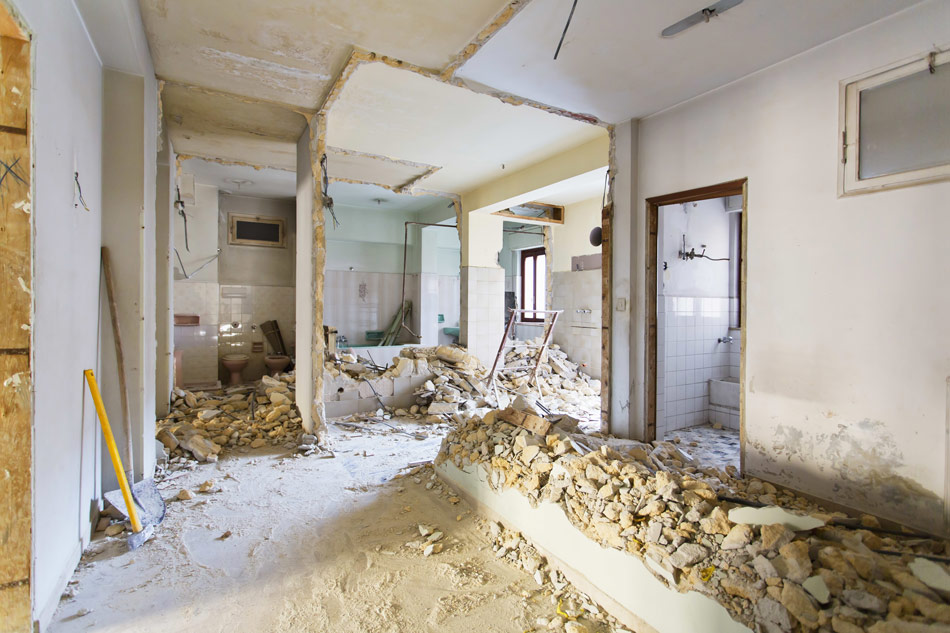The most common reasons that people choose to demolish their home are to make space available to build a new home and when the house contains so many structural issues that repairing it doesn’t make sense. People who want to attempt home demolition on their own need a detailed plan before they do any work. They also need to weigh whether they have the skills, physical strength, and proper tools to do the job well.
If you’re consider doing a DIY tear-down of a room or structure, consider the following demolition tips and advice.
Is the Tear-Down Structural or Non-Structural?
Demolition of a house is structural if involves altering or moving a beam, bearing wall, post, lintel, header, or footing. As a result, people can do significant damage to their homes by attempting to complete a structural demolition on their own. Another consideration for homeowners is that they must be able to determine which structures are load-bearing and which are not load-bearing.
A structure incapable of bearing substantial weight is typically safe for people to remove on their own. Therefore, the simplest way to determine whether a wall is load-bearing is if it runs parallel to joists. Basement stud walls are typically not load-bearing, but homeowners must check all walls since some are the exception. Since headers and posts typically bear weight, homeowners should avoid removing them.
According to a recent article published on the website HGTV.com, homeowners can manage a variety of demolition tasks themselves. However, the professional remodeler who wrote the article feels that some tasks related to demolition are too complex for homeowners to manage alone. Therefore, here are examples of jobs that he recommends outsourcing to a professional.
- Asbestos, lead, and toxic mold removal
- HVAC work
- Homes over one story high
- Electrical work
- Garages, sheds, and other landscape structures
- Natural gas
- Plumbing
- Roofing and siding
- Pool demolition
How to Prepare to Take Down a House
Homeowners who still have a mortgage on the property must contact the lender before proceeding with a demolition project. Lenders that grant permission for demolition may also be able to help homeowners secure financing for both demolition and rebuilding. Other preparation and demolition tips include:
- Acquire a permit to proceed with the demolition from the city. By contrast, those who choose to work with a demolition contractor, that person should know the steps involved in applying for and obtaining the permit.
- Turn off all utilities including gas lines, electric lines, and water. Homeowners also need to contact their utility provider to request that a worker come to the home to cap all utilities. The service provider will also do a walk-through of the home to make sure that the homeowner disconnected all utilities correctly.
- Remove all personal belongings and furniture. No bulky items should remain in the home once the demolition starts. This includes things like light fixtures and appliances.
- Arrange to have a roll-off dumpster onsite to discard debris from the demolished home or hire a construction debris hauling service.
Homeowners will also need to gather or rent several types of tools, heavy equipment, and safety gear. These items include:
- Barrier tape
- Bulldozer
- Dry wall hook
- Eye goggles
- Hard hat
- Hydraulic backhoe or excavator
- Ladder
- Masonry drill
- Putty knife or chisel
- Plastic sheeting
- Pry bar
- Ratcheting tubing cutter
- Reciprocating saw
- Rotary hammer
- Safety cones
- Shop vacuum
- Sledgehammer
- Stud finder
- Surgical mask
- Utility knife or box cutter
- Volt cutter
- Wire cutter
- Wheelbarrow
- Work gloves
The remaining demolition tips depend on whether the homeowner has decided to rent an excavator or tear the house down by hand.
Completing Demolition of the Home

People who choose to use heavy equipment to tear down their home must secure the area to create a safety perimeter. Next, swing the arm of the excavator over the roof to take it down first. Repeat this process with each wall of the home and cave in the floor as the last demolition step. Finally, transport debris to the roll-off dumpster and arrange for pick-up or determine where to dump the debris.
Homeowners completing a manual demolition process should start with the drywall. This will require removing wallpaper with a putty knife and chisel if necessary. Then, the next step is to locate studs using the stud finder, mark the location of each, and use a sledgehammer to begin knocking out sheets of drywall. Here are the remaining demolition tips steps for manually tearing down a home.
- Remove doors and their frames.
- Remove all flooring material, starting with the bathroom and kitchen. Then, move on to the hallways, bedroom, and living room.
- Demolish the bathrooms.
- Disconnect fixtures in the laundry room like sinks, wash machines, and clothes dryers and be sure to uninstall them properly. Then, move on to removing floors, walls, and cabinets.
- Demolish the dining room and kitchen.
This process takes care of the inside of the house, but homeowners will still need to demolish the outside using heavy equipment. Moreover, using heavy equipment for the whole process could potentially save people thousands of dollars.

